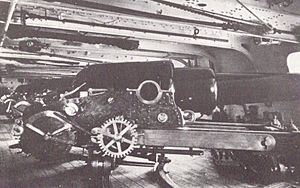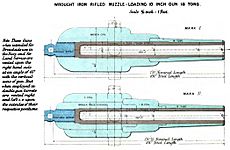RML 10-inch 18-ton gun facts for kids
Quick facts for kids Ordnance RML 10-inch 18-ton gun |
|
|---|---|

Mk I gun on broadside ironclad HMS Sultan in the 1890s
|
|
| Type | Naval gun Coastal gun |
| Place of origin | United Kingdom |
| Service history | |
| In service | 1868–1904? |
| Used by | Royal Navy Australian Colonies |
| Wars | Bombardment of Alexandria |
| Production history | |
| Designer | M Robert Fraser, Royal Gun Factory |
| Designed | 1868 |
| Manufacturer | Royal Arsenal |
| Unit cost | £1,006 |
| Variants | Mks I – II |
| Specifications | |
| Barrel length | 145.5 inches (3.70 m) (bore) |
|
|
|
| Shell | 400 to 410 pounds (181.4 to 186.0 kg) Palliser, Common, Shrapnel |
| Calibre | 10-inch (254.0 mm) |
| Muzzle velocity | Palliser : 1,364 feet per second (416 m/s) Common & shrapnel : 1,028 feet per second (313 m/s) |
| Maximum firing range | 6,000 yards (5,500 m) |
The RML 10-inch guns Mk I – Mk II were very large cannons. They were used on British warships and coastal defenses. These guns were designed in the 1860s and used until the early 1900s. RML stands for "Rifled Muzzle-Loading," meaning the inside of the barrel had grooves (rifling) to make shells spin. This made them more accurate.
How the Gun Was Designed
The 10-inch gun was a special design from the "Woolwich" factory in 1868. It was based on an earlier successful 9-inch gun. These guns used a design called the "Fraser" system. This system helped make the heavy cannons cheaper to build.
The gun had a strong steel barrel. This barrel was wrapped with strong iron coils. These coils helped make the gun very tough. The gun had 7 grooves inside its barrel. These grooves made the shells spin as they left the gun. This spin helped the shells fly straight and hit their targets.
The first ship to use these guns was HMS Hercules. It was finished in late 1868. Some of the early Mk I guns had problems. Their barrels sometimes cracked. Because of this, only a few (at least 25) Mk I guns were made.
Types of Ammunition
When the 10-inch gun was first used, its shells had small "studs" on them. These studs fit into the grooves inside the gun barrel. This made the shell spin when fired.
Later, new parts called "gas-checks" were added to the shells. These gas-checks helped the shells spin better. They also made the guns last longer. After this, new shells were made without studs. This meant the guns could use both old studded shells and new studless shells.
The main type of shell was called "Palliser" shot. This was a special shell designed to break through the armor of enemy warships. To make the Palliser shell go very fast, a large amount of gunpowder was used. This was called a "battering charge."
Other types of shells included "Common" shells, which were regular explosive shells. There were also "Shrapnel" shells. These shells exploded in the air and sent out many small pieces. For these shells, a smaller amount of gunpowder was used. This was called the "full service charge."
Where You Can See Them Today
Many of these historic guns still exist today. You can find them in different places around the world.
- Four guns are underwater near the old ship HMVS Cerberus in Australia.
- A damaged Mk I gun from HMVS Cerberus is on display at HMAS Cerberus in Australia.
- A Mark II gun is at Parson's Lodge Battery in Gibraltar.
- Another Mark II gun is at York Redoubt in Halifax, Canada.
- A Mark II gun is at Southport Gates in Gibraltar.
- Several Mk II guns are at Fort St. Catherine in Bermuda. These guns were moved from Fort Albert.
- A Mark II gun is at Almeda Gardens in Gibraltar.
- Several Mark II guns are at Fort Cunningham on Paget Island, Bermuda.
- A Mark II gun is at the Citadel in Quebec City, Canada.
- A single gun is at Chapel Bay Fort in the United Kingdom.
- You can see different types of 10-inch shells at the Geelong Maritime Museum in Australia.
Other guns are located in Bermuda. Some are outside Fort St Catherine. Others were found buried in the moat of Fort Cunningham. Two guns are at Fort Hamilton. Another is at Alexandria Battery.
See also
- List of naval guns








